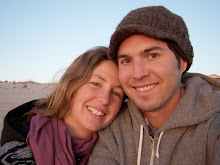
We recently had the pleasure of visiting the Ecology Action Mini-Farm of John Jeavons in Willits, California. This mini-farm is set up as an educational resource teaching people the sustainable practices of having a closed system farm. Whereby one grows all of their food, makes all of their own compost, and builds (rather than depletes) their soil. Jeavons has grown food for the last 37 years and has traveled the world teaching people how to not only feed themselves cheaply and efficiently, but also with being good stewards to our planet. The rate at which we are depleting soil around the planet is incredible- due to having huge agribusiness and non-local production of most of our food needs. Even gardeners who do not use their own compost are depleting someone else's resources.
Ecology Action has created a way to grow food called the Grow Biointensive. There are 8 important aspects of this method:
1)Deep soil preparation- called the double dig method. Which involves aerating the soil two feet down so that healthy soil organisms- like fungi, bacteria, and worms to name a few- can move in and begin creating a healthy soil environment for plants to grow.
2)Composting- using broken down kitchen waste, garden trimmings and other organic matter to provide nutrition to the soil, rather than depleting it.
3)Close plant spacing- creating a “mini-climate” for plants which helps retain moisture, protects valuable microbiotic life, retards weeds growth and facilitates higher yields.
4)Companion planting- some plants grow well, if not better, together. Using this knowledge to create a healthier garden space. This also includes planting certain flowers to attract beneficial insects to the garden.
5)Carbon-efficient crops- planting approx. 60% of the crop to be seed or grain crop, which also produces much needed carbonaceous material for the compost pile. Some examples are wheat, oats, corn, sorghum, fava beans, filberts, sunflowers.
6)Calorie-efficient crops- planting approx. 30% of the crop to yield high calorie crops- such as potatoes, sweet potatoes,leeks, garlic, beans, onions.
The last 10% will be vegetables to provide most of the vitamin and mineral content (and taste!!) of the food.
7)The use of open-pollinated seeds- the use of seeds that have been used for centuries that preserve the worlds genetic diversity.
8)A whole garden system- it is important to know that one should use the whole system to make this work. If someone grows this high of yields without composting or deep soil preparation the soil can be rapidly depleted- which is no good for anyone.
Growing food is fun. And so wonderful for your health and family. It was really cool to be inspired to do more good things for this planet. I don't know if we'll do all of it, but we sure can incorporate a lot of it into our future food growing plans. We both feel that there may be a time in the not so distant future when we have to grow our own food. Let's all plant victory gardens!!! Who could possibly be unhappy when you set foot into a beautiful garden bursting with delicious food. For more info you can buy How to Grow More Vegetables by John Jeavons or visit www.bountifulgardens.org.

I also took a class on solar cooking. Did you know that you can cook just about anything in a solar cooker??? Rice, cookies, vegetables, bread, purify water, canning... you name it. And, it is powered for free, by the sun!!! It just takes a little pre- thought and a little extra time. Nothing crazy!! And...the food tastes so much better because it is cooked at lower temps (200-250 degrees) for longer and it hasn't oxidized. I can't wait!! I'm getting all the solar cooking things I need for my birthday from Tony. Let's eat!!! And feel damn good about it!

No comments:
Post a Comment